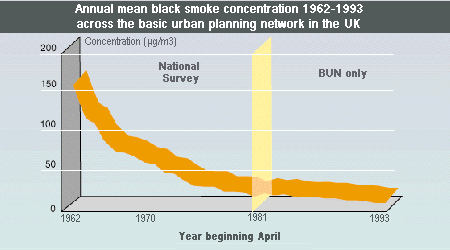| In the UK and
indeed elsewhere in Europe smogs, accompanied by
respiratory diseases had been accepted as the
"price" of industrial progress. However, the
infamous smog (smoke + fog = smog) which blanketed London
from the 5-8 December 1952, and which was responsible for
4700 additional deaths, finally spurred the Government
into action. The result was the Clean Air Act
1956. This
Act, which was amended in 1968, regulated pollution from
smoke, grit and dust from domestic, commercial and
industrial sources. The legislation prohibited the
emission of "dark smoke" from any chimney and
enabled local authorities to declare all or part of their
area a "smoke control area". In such areas it
is an offense to emit smoke unless it can be proved that
only an "authorised fuel" (listed in
Regulations) had been used. Certain fireplaces -
"exempted fireplaces" - which can burn other
types of (unauthorised) fuels may be utilised so long as
they can do so without emitting any, or a substantial
quantity of, smoke.
In a smoke control area, the
local authority may serve a notice on the owner of a
private dwelling (i.e. not commercial or industrial
premises) requiring fireplaces to be adapted to smokeless
operation. So long as the work has been carried out to
the local authority's satisfaction, it should repay
seven-tenths of the reasonable cost of the work; it had
the option of repaying all or part of the remaining
three-tenths. Grants were not available for
"new" dwellings begun on or after 16 August
1964. Until the end of 1996 local authorities could
reclaim from the Government a proportion of their
expenditure for grants made towards the conversion of
domestic fires to smokeless operation.
Although most local authorities have
either completed or, for one reason or another, stopped
their smoke control programme, some are still continuing.
Thus while the total costs of implementing a smoke
control programme can be considerable, in the UK the
costs have been spread over some 40 years. The costs for
individual authorities will depend on the number of
houses involved and local appliance and installation
costs
|
 |



Document Actions
Share with others